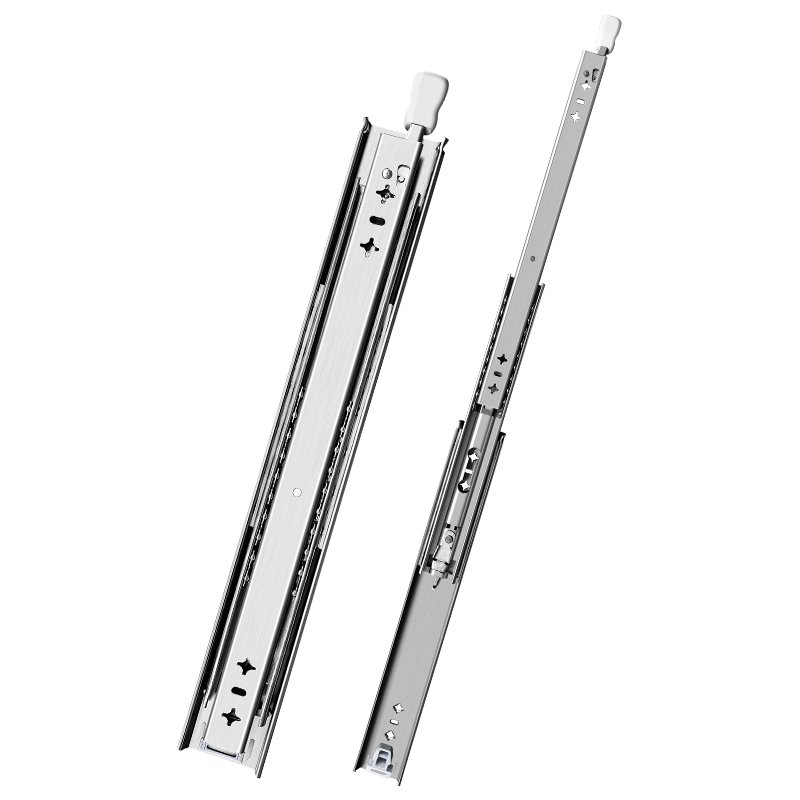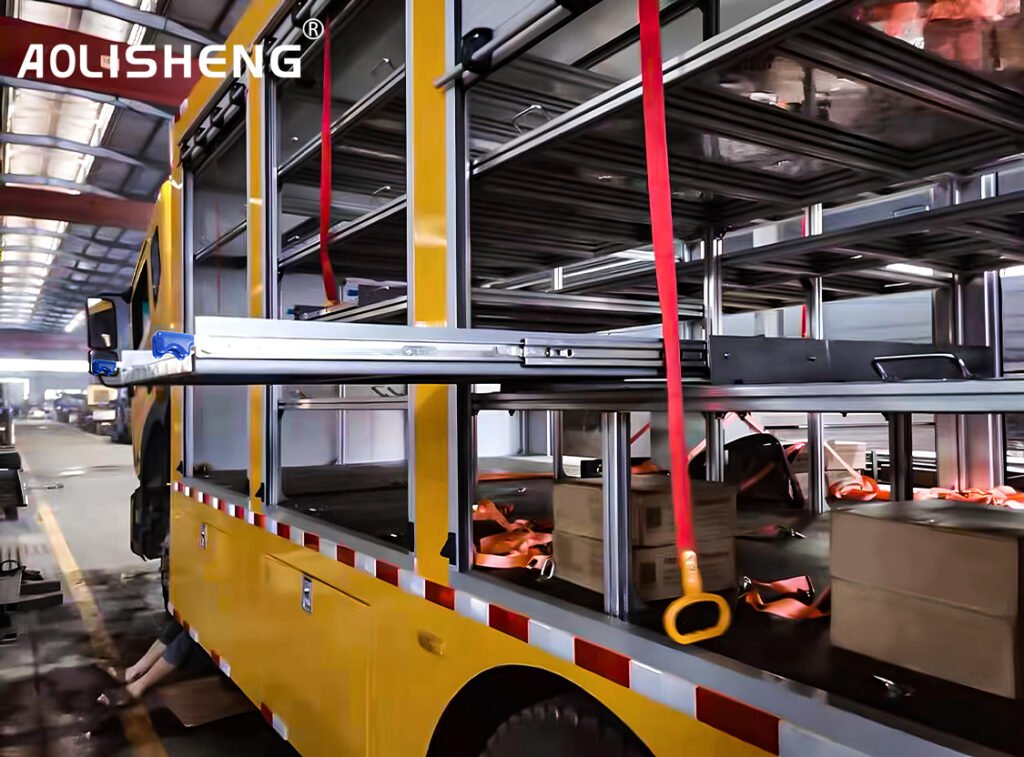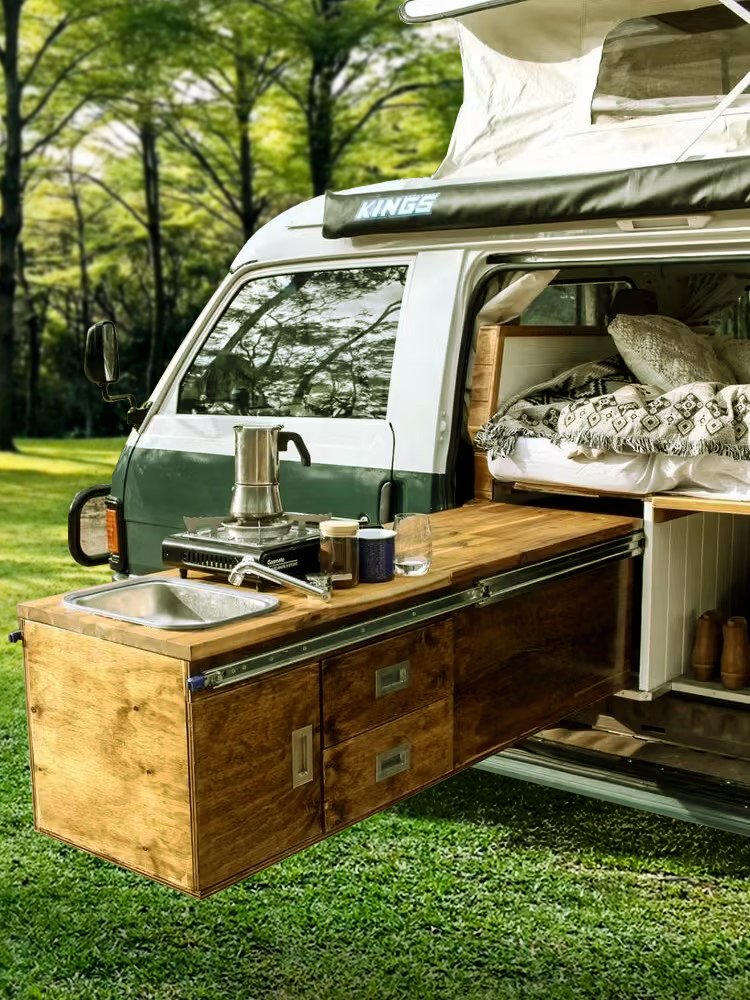stainless steel drawer slides
Looking for a different size or weight capacity? Click below to discover our full range of heavy-duty drawer slides that perfectly fit your needs!

Heavy Duty Stainless Steel Locking Drawer Slides - W2053D
265 lbs
Material: Stainless steel 304
Slide width: 53mm
Installation thickness: 19.4±0.5mm
Slide length: 10″ to 40″
Load bearing: 18“265 lbs (120kg)
Level of travel: Full Extension
Mounting type: Side Mount
Customizable heavy duty stainless steel locking drawer slides size, function, hole position, color, etc.
Application Segment
vehicle modification, industrial storage, medical equipment storage, electronic products, etc.


Specific Advantages of
Heavy Duty Locking Drawer Slides
1. Enhanced Safety and Stability: Heavy duty locking drawer slides reduce the risk of accidents and equipment damage by securely fixing devices or items, particularly in high-risk or frequently moved environments.
2. Operational Convenience and Flexibility: Designed for easy locking and releasing, heavy duty locking drawer slides save time and labor costs, enhancing operational convenience and efficiency.
3. Maintenance Cost and Efficiency: Stable equipment fixation reduces repair and replacement costs caused by equipment movement or instability, prolonging equipment lifespan and reliability.
In summary, heavy duty locking drawer slides are critical in enhancing safety and stability improving operational efficiency, and ensuring long-term equipment reliability in applications requiring precise position control and secure fixation.


Specific Advantages of
Heavy Duty Stainless Steel Locking Drawer Slides
1. Excellent Corrosion Resistance: Stainless Steel 304 exhibits outstanding corrosion resistance, making heavy duty stainless steel locking drawer slides suitable for use in various environments, including those exposed to acids and alkalis.
2. High-Temperature Resistance: Stainless Steel 304 maintains good performance even at high temperatures, which makes heavy duty stainless steel locking drawer slides suitable for applications in environments with elevated heat.
3. Good Formability and Machinability: Stainless Steel 304 is easily formed and machined, allowing for the manufacture of complex shapes and sizes required for heavy duty stainless steel locking drawer slides.
4. Aesthetic Appeal and Durability: With its bright surface finish and modern appearance, Stainless Steel 304 is aesthetically pleasing and durable, suitable for applications where appearance and longevity are important.
5. Easy to Clean and Maintain: The smooth surface of Stainless Steel 304 resists dirt and grime buildup, facilitating easy cleaning and requiring minimal maintenance.
6. Environmentally Friendly and Safe: Stainless Steel 304 is safe for food and medical applications, meeting stringent health and safety standards.
In summary, heavy duty stainless steel locking drawer slides are favored for their exceptional corrosion resistance, high-temperature performance, ease of fabrication, aesthetic appeal, durability, and ease of maintenance, making them ideal for various industrial and everyday applications.
Our Services
MOQ Offered
We provide flexible minimum order quantities, allowing you to start small and scale up as needed.
Large Inventory
Ensuring Ample Stock for Immediate Shipment, Eliminating Wait Times for Production.
Complete Specifications
We refine various specifications of drawer slides according to different usage scenarios.
AOLISHENG produces heavy duty stainless steel locking drawer slides with standard specifications and provides customized solutions to meet your project needs.
Why Choose AOLISHENG
Rich Experience
- 15 years of industry experience.
- Extensive customization experience.
Production Automation
- Over 90% automation in production.
- Production efficiency increased by more than 10 times.
Quality Assurance
- High-quality products certified with SGS and EN standards.
- Stringent inspection department.
Mass Production
- Factory area of over 40,000 square meters.
- Daily production capacity of over 100,000 sets.
Leading Quality
- Hundreds of professional production machines.
- 5 times product accuracy.
We Look Forward To Your Contact
AOLISHENG is your trusted global partner for high-quality drawer slide production, with strategic factories worldwide and professional local service teams. Partnering with AOLISHENG ensures efficient project delivery, robust supply chains, expert technical support, and a thriving customer base.
FAQ
How do you make a steel slide slippery?
To make the steel slide rail slide smoothly, the following measures can be taken to reduce friction and improve sliding performance:
1. Lubrication
Choose lubricant:
Oil-based lubricants: such as motor oil, liquid paraffin, or special slide rail lubricants are suitable for reducing friction and providing long-lasting lubrication.
Dry lubricants: such as graphite powder or molybdenum disulfide, these lubricants can reduce the accumulation of dust and impurities while keeping the slide rail smooth.
Silicone oil: Silicone oil is an efficient lubricant suitable for various metal slide rails, which can provide a good sliding effect and resist high temperatures.
Apply lubricant:
Cleaning surface: Before applying lubricant, make sure the surface of the slide rail is clean and remove any dust, dirt, or old lubricant to avoid affecting the lubrication effect.
Evenly apply: Apply lubricant evenly on the contact surface of the slide rail to ensure that the sliding part of the slide rail is fully lubricated.
Regular maintenance: Check and reapply lubricant regularly to maintain smooth sliding and extend the service life of the slide rail.
2. Use rail pads
Padding materials: Using padding materials such as polytetrafluoroethylene (PTFE) or nylon pads between the rail and the drawer can reduce friction and improve sliding performance. These materials have good sliding characteristics and can significantly improve the smoothness of steel rails.
3. Surface treatment
Polished surface: Mechanically polish the rail to remove roughness and unevenness on the surface and make it smoother. A smooth surface can reduce friction and improve the sliding effect.
Coating treatment: Apply wear-resistant and low-friction coatings such as chrome plating, nickel plating, or special lubricating coatings. These coatings can reduce friction and improve the durability of the rail.
4. Ensure proper alignment
Installation check: Ensure that the rail and drawer are properly aligned. The installation of the rail should meet the design requirements to avoid increased friction due to poor alignment.
Adjust the rail: During the installation process, adjust the rail position and clearance to ensure smooth sliding and reduce unnecessary friction.
5. Choose the right rail design
High-quality design: Choose a high-quality steel rail design, especially those with ball bearings or rollers. These designs can effectively reduce friction and provide a smoother sliding experience.
Load management: Ensure that the load-bearing capacity of the slide rail meets the actual use requirements. Excessive loads will cause uneven sliding, so the appropriate slide rail should be selected according to actual needs.
Summary
To make the steel slide rail slide smoothly, lubrication, use of slide rail pads, surface treatment, ensuring correct alignment, and choosing a suitable slide rail design can be achieved. Regular maintenance and inspection are also important measures to ensure that the slide rail runs smoothly for a long time. Through these methods, the sliding performance of the steel slide rail can be significantly improved, friction can be reduced, and the use experience can be improved.
What material is stainless steel plate?
A Stainless Steel Plate is a metal plate made of stainless steel. Here are the details about stainless steel plate materials:
Basic composition of stainless steel
Main ingredients: Stainless steel is an alloy mainly composed of iron (Fe), chromium (Cr), and nickel (Ni). The chromium content is usually between 10.5% and 30%, which makes stainless steel corrosion-resistant. The addition of nickel improves the corrosion resistance and mechanical properties of stainless steel.
Other elements: Depending on the type of steel, stainless steel may also contain other elements, such as molybdenum (Mo), titanium (Ti), manganese (Mn), etc., which will affect the characteristics of stainless steel.
Classification of stainless steel plates
Stainless steel plates can be divided into different types according to their chemical composition and organizational structure, mainly including:
1. Austenitic stainless steel
Composition: Usually contains 16%-26% chromium and 6%-22% nickel, and some also contain molybdenum.
Features: It has excellent corrosion resistance and high-temperature resistance, moderate strength, good ductility, and is not easily magnetized. Common models include 304, 316, etc.
Application: Widely used in the chemical industry, food processing, medical equipment, and other fields.
2. Ferritic Stainless Steel
Composition: Usually contains 10.5%-27% chromium and less nickel.
Features: Good corrosion resistance and heat resistance, but lower strength than austenitic stainless steel. Strong magnetism and relatively poor ductility. Common models include 430.
Application: Commonly used in automobile exhaust systems, kitchen utensils, etc.
3. Martensitic Stainless Steel
Composition: Contains 12%-18% chromium and less nickel, and may also contain carbon.
Features: High strength and hardness, but relatively poor corrosion resistance. Hardness can be enhanced by heat treatment. Common models include 410 and 420.
Application: Used in knives, bearings, tools, and other occasions that require high strength and wear resistance.
4. Duplex Stainless Steel
Composition: Contains high chromium (19%-28%) and nickel (4.5%-8%), and some also contain molybdenum.
Features: Combines the stainless steel characteristics of austenite and ferrite, with excellent corrosion resistance and high strength. The strength is higher than austenitic stainless steel, and the corrosion resistance is better than ferritic stainless steel.
Application: Widely used in petrochemical, marine engineering, pulp and paper industry, and other fields.
Specifications of stainless steel plate
Thickness: The thickness of a stainless steel plate usually ranges from 0.1 mm to tens of mm. Common thickness specifications are 1 mm, 2 mm, 3 mm, 5 mm, etc.
Size: Stainless steel plate can be cut into different sizes as needed. The standard plate size is usually 1000 mm × 2000 mm, 1500 mm × 3000 mm, etc.
Surface treatment: A stainless steel plate can be subjected to different surface treatments, such as polishing, brushing, sandblasting, etc., to meet different application requirements and aesthetic requirements.
Features and advantages of stainless steel plates
Corrosion resistance: The chromium content of stainless steel plates improves their corrosion resistance and can resist moisture, oxidation, and most acidic and alkaline substances.
High strength: After appropriate heat treatment, stainless steel plates have high mechanical strength and hardness.
High-temperature resistance: Able to maintain good mechanical properties in high-temperature environments.
Aesthetics: The surface is smooth, easy to clean, and maintains a good appearance.
Summary
Stainless steel plates are metal sheets made of stainless steel alloys with excellent corrosion resistance, strength, and aesthetics. Depending on different application requirements, stainless steel plates can have different compositions and treatments to meet various industrial and design requirements.
Are slides made of stainless steel?
Yes, stainless steel is available for the slides. Stainless steel drawer slides are often used in high-end and special application drawer systems due to their excellent properties. Here are the details about stainless steel drawer slides:
Features of stainless steel drawer slides
1. Corrosion resistance
Anti-oxidation: Stainless steel has excellent corrosion resistance and can resist the erosion of water, moisture, and chemicals. This makes stainless steel drawer slides very suitable for use in humid environments such as kitchens and bathrooms.
Long-term durability: Even in harsh environments, stainless steel drawer slides can maintain good performance and appearance and are not easy to rust or corrode.
2. Strength and durability
High load-bearing capacity: Stainless steel drawer slides usually have high strength and load-bearing capacity, suitable for heavy drawers and high-frequency use scenarios.
Wear resistance: Stainless steel materials are strong and durable and can resist long-term friction and wear.
3. Beautiful
Modern appearance: Stainless steel drawer slides have a smooth surface and a modern appearance that matches a variety of furniture styles. Its gloss and texture can enhance the grade of the overall design.
Easy to clean: Dirt is not easy to adhere to the surface of stainless steel, and it is relatively simple to clean, which can maintain a long-term smooth appearance.
4. Smooth operation
Sliding performance: Many stainless steel drawer slides are equipped with ball bearing design or other efficient sliding mechanisms to ensure a smooth and quiet sliding process.
Stability: Due to its material properties, stainless steel drawer slides provide good stability and reduce the wobble of drawers during sliding.
Application scenarios
Kitchen and bathroom: Due to its corrosion resistance, stainless steel drawer slides are very suitable for wet environments such as kitchens and bathrooms.
High-end furniture: In high-end furniture, stainless steel drawer slides are often used on occasions that require high durability and aesthetics.
Industrial applications: Also suitable for industrial environments that require durable and corrosion-resistant drawer systems.
Summary
Stainless steel drawer slides are suitable for a variety of demanding application scenarios due to their excellent corrosion resistance, strength, durability, and modern aesthetics, especially in humid or high-load environments. Although its price may be relatively high, its performance and lifespan generally provide good cost-effectiveness.
What material is best for slides?
Choosing the best material for slides depends on a variety of factors, including the environment in which they will be used, the load-bearing requirements, and your budget. Here are the pros and cons of different materials to help you make an informed choice:
1. Steel:
Pros:
High strength: Strong load-bearing capacity, suitable for heavy drawers.
Relatively low cost: High cost-effective, suitable for all budgets.
Good durability: After treatment (such as galvanizing, and powder coating), it has good corrosion resistance.
Cons:
May rust: Especially in environments with high humidity, rust may occur if not treated properly.
Applicable scenarios: From ordinary homes to commercial furniture, heavy drawers, etc. are suitable.
2. Stainless Steel:
Pros:
Highly corrosion-resistant: Stainless steel drawer slides are ideal for environments with high humidity or contact with water.
Excellent durability: High strength and long service life.
Modern appearance: It has a modern and shiny look.
Cons:
Higher cost: Stainless steel drawer slides are more expensive than ordinary steel drawer slides.
Applicable scenarios: High-end furniture, kitchens, bathrooms, and other humid environments.
3. Aluminum:
Advantages:
Lightweight: Lightweight, reduces the need for supporting structures.
Corrosion-resistant: Naturally resistant to corrosion, suitable for environments with high humidity.
Elegant appearance: Often used in modern designs, with a clean and neat appearance.
Disadvantages:
Limited load-bearing capacity: Generally not as strong as steel, suitable for medium and light applications.
Applicable scenarios: Modern furniture, designs that need to reduce weight, and environments with high humidity.
4. Plastic:
Advantages:
Lightweight and quiet: Less noise during operation.
Lower cost: Suitable for projects with limited budgets.
Disadvantages:
Poor durability: May wear out after long-term use, and has low load-bearing capacity.
Applicable scenarios: Light drawers, small furniture, or applications with specific design requirements.
Summary
For heavy-duty applications: Steel or stainless steel drawer slides are the best choice because of their high load-bearing capacity and durability.
For modern or high-humidity environments: Aluminum and stainless steel drawer slides are more suitable because they are corrosion-resistant and have a modern appearance.
For light applications and projects with limited budgets: Plastic slides can be an economical and practical choice.
Depending on your specific needs and budget, choosing the right material will ensure the performance and longevity of your slide.
How do you make metal drawers slide smoothly?
To make metal drawers slide smoothly, there are several aspects to adjust and maintain:
1. Choose high-quality stainless steel drawer slides
Ball bearing slides: provide a smooth sliding experience and reduce friction.
Bottom-mounted slides: are usually smoother and quieter because they are designed to fit tightly with the bottom of the drawer.
2. Properly install stainless steel drawer slides
Horizontal alignment: Make sure the slides are installed horizontally to avoid excessive pressure on one side of the drawer.
Symmetrical installation: Make sure the left and right slides are installed symmetrically so that the drawer is evenly stressed when sliding.
Precise docking: The docking of the slides and drawers needs to be precise to avoid jamming or resistance.
3. Keep stainless steel drawer slides clean
Regular cleaning: Use a clean cloth or brush to remove dust and debris from the slides. Dust accumulation will increase friction and affect the sliding effect.
Avoid moisture: Try to prevent moisture from entering the slides to avoid rust or corrosion.
4. Lubricate stainless steel drawer slides
Choose the right lubricant: Use lubricants such as silicone oil and graphite powder to reduce friction between the slides and drawers. Avoid using oil-based lubricants, as they may attract dust and cause more wear.
Lubrication method: Apply lubricant evenly to the slide rails, making sure that all contact parts between the slide rails and the drawer are lubricated. Check and reapply lubricant regularly.
5. Check and adjust the load
Avoid overloading: Do not put items in the drawer that exceed the load-bearing capacity of the slide rails. Excessive weight may cause the slide rails to deform or wear.
Distribute the weight evenly: Make sure the items inside the drawer are evenly distributed to prevent one side from being too heavy and causing uneven sliding.
6. Check the fit of the drawer and the stainless steel drawer slides
Correct drawer unevenness: Check whether the bottom of the drawer is flat. If there is unevenness, it needs to be trimmed. Unevenness at the bottom of the drawer may cause the slide rails to get stuck.
Check the fit of the slide rails and drawers: Make sure that the interface between the slide rails and the drawer is not worn or deformed. If problems are found, the slide rails may need to be replaced or adjusted.
7. Use the appropriate type of slide rails
Soft closing function: Some high-end slide rails are equipped with a soft closing function, which can provide a smoother and quieter sliding experience while reducing impact and noise.
8. Regular maintenance
Regular inspection: Check the status of the slide rails regularly, clean dust and debris in time, and check whether relubrication or adjustment is needed.
Repair or replacement: If the slide rails are found to be worn or damaged, repair or replace them in time to ensure that the drawer can continue to slide smoothly.
The above methods can effectively improve the sliding smoothness of metal drawers and extend the service life of the slide rails.
